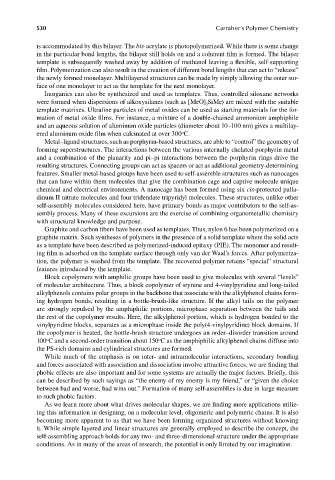Page 567 - Carrahers_Polymer_Chemistry,_Eighth_Edition
P. 567
530 Carraher’s Polymer Chemistry
is accommodated by this bilayer. The bis-acrylate is photopolymerized. While there is some change
in the particular bond lengths, the bilayer still holds on and a coherent fi lm is formed. The bilayer
template is subsequently washed away by addition of methanol leaving a fl exible, self-supporting
film. Polymerization can also result in the creation of different bond lengths that can act to “release”
the newly formed monolayer. Multilayered structures can be made by simply allowing the outer sur-
face of one monolayer to act as the template for the next monolayer.
Inorganics can also be synthesized and used as templates. Thus, controlled siloxane networks
were formed when dispersions of alkoxysilanes (such as [MeO] SiMe) are mixed with the suitable
3
template matrixes. Ultrafine particles of metal oxides can be used as starting materials for the for-
mation of metal oxide films. For instance, a mixture of a double-chained ammonium amphiphile
and an aqueous solution of aluminum oxide particles (diameter about 10–100 nm) gives a multilay-
o
ered aluminum oxide film when calcinated at over 300 C.
Metal–ligand structures, such as porphyrin-based structures, are able to “control” the geometry of
forming superstructures. The interactions between the various internally chelated porphyrin metal
and a combination of the planarity and pi–pi interactions between the porphyrin rings drive the
resulting structures. Connecting groups can act as spacers or act as additional geometry-determining
features. Smaller metal-based groups have been used to self-assemble structures such as nanocages
that can have within them molecules that give the combination cage and captive molecule unique
chemical and electrical environments. A nanocage has been formed using six cis-protected palla-
dinum II nitrate molecules and four tridendate tripyridyl molecules. These structures, unlike other
self-assembly molecules considered here, have primary bonds as major contributors to the self-as-
sembly process. Many of these excursions are the exercise of combining organometallic chemistry
with structural knowledge and purpose.
Graphite and carbon fibers have been used as templates. Thus, nylon 6 has been polymerized on a
graphite matrix. Such syntheses of polymers in the presence of a solid template where the solid acts
as a template have been described as polymerized-induced epitaxy (PIE). The monomer and result-
ing film is adsorbed on the template surface through only van der Waal’s forces. After polymeriza-
tion, the polymer is washed from the template. The recovered polymer retains “special” structural
features introduced by the template.
Block copolymers with amphilic groups have been used to give molecules with several “levels”
of molecular architecture. Thus, a block copolymer of styrene and 4-vinylpyridine and long-tailed
alkylphenols contains polar groups in the backbone that associate with the alkylphenol chains form-
ing hydrogen bonds, resulting in a bottle-brush-like structure. If the alkyl tails on the polymer
are strongly repulsed by the amphiphilic portions, microphase separation between the tails and
the rest of the copolymer results. Here, the alkylphenol portion, which is hydrogen bonded to the
vinylpyridine blocks, separates as a microphase inside the poly(4-vinylpyridine) block domains. If
the copolymer is heated, the bottle-brush structure undergoes an order–disorder transition around
o
o
100 C and a second-order transition about 150 C as the amphiphilic alkylphenol chains diffuse into
the PS-rich domains and cylindrical structures are formed.
While much of the emphasis is on inter- and intramolecular interactions, secondary bonding
and forces associated with association and dissociation involve attractive forces, we are fi nding that
phobic effects are also important and for some systems are actually the major factors. Briefl y, this
can be described by such sayings as “the enemy of my enemy is my friend,” or “given the choice
between bad and worse, bad wins out.” Formation of many self-assemblies is due in large measure
to such phobic factors.
As we learn more about what drives molecular shapes, we are fi nding more applications utiliz-
ing this information in designing, on a molecular level, oligomeric and polymeric chains. It is also
becoming more apparent to us that we have been forming organized structures without knowing
it. While simple layered and linear structures are generally employed to describe the concept, the
self-assembling approach holds for any two- and three-dimensional structure under the appropriate
conditions. As in many of the areas of research, the potential is only limited by our imagination.
9/14/2010 3:43:07 PM
K10478.indb 530 9/14/2010 3:43:07 PM
K10478.indb 530

